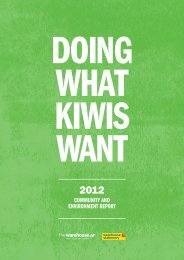ar11-lr-final
You also want an ePaper? Increase the reach of your titles
YUMPU automatically turns print PDFs into web optimized ePapers that Google loves.
Corporate Governance – continued<br />
Corporate Governance – continued<br />
Board and Committee Meetings<br />
The Board normally meets at least nine times a year and whenever necessary to deal with specific matters. The Board committees<br />
meet either quarterly or are convened as necessary. Each committee is entitled to the resources and information it requires to<br />
operate effectively.<br />
All Directors can attend any committee meeting at the invitation of the relevant committee, with the CEO and the CFO attending the<br />
Audit Committee by standing invitation. Senior management is also available to address queries, and to assist in the understanding<br />
of issues facing the company.<br />
The main Board formally met nine times during the year. In addition, Directors met throughout the year on matters of strategy,<br />
planning, committee business, and to attend to business between meetings. The table below shows Director attendance at the<br />
formal Board meetings and committee member attendance at committee meetings during the year ended 31 July 2011.<br />
BOARD<br />
AUDIT<br />
REMUNERATION,<br />
TALENT AND<br />
NOMINATION<br />
CORPORATE<br />
GOVERNANCE<br />
DISCLOSURE<br />
COMMITTEE<br />
Number of meetings 9 4 6 1 2<br />
Mark Callaghan 1 7 2<br />
Robert Challinor 9 4 1 2<br />
Graham Evans 9 4 6 1<br />
Ian Morrice 2 7 1<br />
James Ogden 9 3 1<br />
Janine Smith 9 6 1<br />
Keith Smith 9 4 6 2<br />
Sir Stephen Tindall 8 5 1<br />
1<br />
Mark Callaghan appointed a Director 10 September 2010 and Remuneration, Talent and Nomination Committee member 1 March 2011<br />
2<br />
Ian Morrice resigned as a Director 2 May 2011<br />
Ted van Arkel appointed a Director 1 July 2011: no formal meetings held in July 2011<br />
Principle 4 – Reporting and Disclosure<br />
The Board demands integrity both in financial reporting and in<br />
the timeliness and balance of disclosures on entity affairs.<br />
Financial Reporting<br />
The Audit Committee oversees the quality and integrity of<br />
external financial reporting including the accuracy, completeness<br />
and timeliness of financial statements.<br />
It reviews half-yearly and annual financial statements and<br />
makes recommendations to the Board concerning accounting<br />
policies, areas of judgement, compliance with accounting<br />
standards, stock exchange and legal requirements, and the<br />
results of the external and internal audits.<br />
Management accountability for the integrity of the company’s<br />
financial reporting is reinforced by certification from the CEO<br />
and CFO. The CEO and CFO provided the Board with written<br />
confirmation that the company’s financial report presents a true<br />
and fair view, in all material respects, of the company’s financial<br />
position for the year ended 31 July 2011, and that operational<br />
results are in accordance with relevant accounting standards.<br />
Timely and Balanced Disclosure<br />
The Warehouse considers that shareholders and the investment<br />
market generally should be promptly informed of all major<br />
business events that influence the company. To achieve and<br />
maintain high standards of disclosure, the Board has approved a<br />
Market Disclosure Policy which is designed to ensure compliance<br />
with NZX and ASX continuous disclosure requirements.<br />
To assist the company with its Market Disclosure Policy, the<br />
Board has appointed a Disclosure Committee. The committee is<br />
responsible for making decisions on what should be disclosed<br />
publicly under the Market Disclosure Policy.<br />
The Company Secretary is the Disclosure Officer of the<br />
company and has responsibility for ensuring compliance<br />
with the continuous disclosure requirements, and overseeing<br />
and co-ordinating disclosure to the market.<br />
Principle 5 – Remuneration<br />
The remuneration of Directors and executives is transparent,<br />
fair and reasonable.<br />
Making sure Team Members receive the rewards they deserve<br />
is the responsibility of the Remuneration, Talent and Nomination<br />
Committee, a committee of the Board. The committee makes<br />
recommendations to the Board on salaries and incentive<br />
programmes and more generally on Group issues, plans and<br />
policies relating to people management. The committee is<br />
assisted by the Human Resources Director, and by external<br />
remuneration advisors.<br />
Non-Executive Directors’ Remuneration<br />
The fees payable to non-executive Directors are determined by<br />
the Board within the aggregate amount approved by shareholders.<br />
The Board considers the advice of independent remuneration<br />
consultants when setting remuneration levels. The current Directors’<br />
fee pool limit is $650,000 which was approved by the shareholders<br />
at the 24 November 2006 Annual Meeting of shareholders.<br />
Details of the remuneration paid to Directors and other benefits<br />
provided by way of salaries, bonus and exercising share rights<br />
are disclosed in note 14 to the Financial Statements.<br />
Senior Executive Remuneration<br />
The objective of the senior managerial remuneration strategy is<br />
to provide competitive remuneration aimed at:<br />
• aligning managers’ rewards with shareholders’ value;<br />
• achieving business plans and corporate strategies;<br />
• rewarding performance improvement; and<br />
• retaining key skills and competencies.<br />
The composition of senior executive remuneration is made up<br />
as follows:<br />
• Base or fixed remuneration – determined by the scope of the<br />
role and the level of knowledge, skill and experience required<br />
by the individual. The main reference point is the salary at<br />
the median of this group although the company is prepared<br />
to pay more to secure and retain the right people to deliver<br />
what the business needs.<br />
• Short-term incentive plan – this comprises an annual<br />
incentive, based on percentage of the fixed remuneration,<br />
dependent on the achievement of key performance and<br />
operating result objectives. For the Executive Team the<br />
bonus is generally up to 50% of base salary for ‘On Target’<br />
performance and is based on a combination of the Group<br />
reported earnings and each executive’s specific objectives.<br />
• Long-term incentive plan – a reward for the achievement of<br />
long-term shareholder return. Under the share rights plan<br />
that has been approved by shareholders, participants may<br />
be entitled to ordinary shares in the company if certain share<br />
price targets are met. Details of the plan, and the share price<br />
targets, are contained in note 15 to the Financial Statements.<br />
Senior executives’ objectives are set annually and reviewed<br />
informally on a monthly basis, with formal reviews in March and<br />
August each year. Objectives are based on a balanced scorecard<br />
of financial, people, customer and process/operations. The CEO’s<br />
objectives are set with the Chairman and Remuneration, Talent<br />
and Nomination Committee and tabled to the Board annually.<br />
Senior management remuneration is detailed in the wider<br />
disclosure made by the company in the Team Members’<br />
remuneration section of the statutory disclosures. Collective<br />
disclosure of remuneration paid to key executives is disclosed<br />
in note 14 to the Financial Statements.<br />
Principle 6 – Risk Management<br />
The Board regularly verifies that the entity has appropriate<br />
processes that identify and manage potential and relevant risks.<br />
Approach to Managing Risk<br />
Risk is the chance of something happening that will have an<br />
impact on business objectives. Having established an acceptable<br />
risk tolerance, The Warehouse’s approach is to identify, analyse,<br />
evaluate and appropriately treat risk in the business.<br />
The company recognises three main types of risk:<br />
• Operational risk – risk to earnings and reputation arising from<br />
inadequate or failed internal processes, people and systems<br />
or from external events;<br />
• Business risk – risk to earnings and reputation from business<br />
event risk, legal, compliance or regulatory risk; and<br />
• Market risk – risk to earnings and reputation arising from<br />
competitor activity, product risk and risk associated with<br />
changes in financial markets (such as interest rate, foreign<br />
exchange and liquidity risk).<br />
Risk Management Roles and Responsibilities<br />
The Board is responsible for reviewing and approving<br />
The Warehouse’s risk management strategy. The Board<br />
delegates day-to-day management of risk to the CEO who<br />
may further delegate such responsibilities to brand chief<br />
executive officers and other officers. Inherent in this<br />
delegation is the belief that responsibility for managing risks<br />
in the business is the domain of the business unit.<br />
CEO and CFO Assurance<br />
The CEO and CFO have provided the Board with written<br />
confirmation that the company’s 2011 financial statements are<br />
founded on a sound system of risk management and internal<br />
compliance and control, and that such systems are operating<br />
efficiently and effectively in all material respects.<br />
Risk Monitoring and Evaluation<br />
The Audit Committee reviews the reports of management and<br />
the external and internal auditors on the effectiveness of systems<br />
for internal control, financial reporting and risk management.<br />
To assist in discharging this responsibility, the Board has in place<br />
a number of strategies designed to safeguard the company’s<br />
assets and interests and ensure the integrity of reporting. These<br />
reports included quarterly reviews of store audit results and<br />
quarterly reports from Ernst & Young on internal audit findings.<br />
The Board of Directors is ultimately responsible for the risk<br />
management of the company. The Business Continuity Management<br />
(BCM) Group Policy spans the four phases of crisis risk management<br />
comprising risk treatment (i.e. mitigation) together with crisis<br />
preparedness, response and recovery. Key aspects of the BCM<br />
Group Policy are audited and aspects of the policy were successfully<br />
implemented following the Canterbury earthquakes. A Strategic Risk<br />
Assessment (SRA) review has identified significant potential risk to<br />
shareholder value and appropriate mitigations. A full review of the<br />
SRA was undertaken in 2011.<br />
Insurance<br />
The company maintains insurance coverage with reputable<br />
insurers for relevant insurable risks and recently renewed its<br />
insurance policies on the same terms for all risks other than<br />
earthquake related losses for which the deductibles increased<br />
in line with the insurance market’s response to global natural<br />
disasters, including the Canterbury earthquakes. The Warehouse<br />
retains a $50,000 insurance deductible for any single event<br />
loss arising from non-earthquake related damage or business<br />
interruption to stores, distribution centres or support offices.<br />
The Warehouse Limited and Warehouse Stationery Limited are<br />
accredited employers under the ACC Partnership Programme for<br />
workers’ compensation insurance. This programme encourages<br />
eligible employers to take responsibility for their own workplace<br />
health and safety, and injury management. This includes<br />
rehabilitation and claims management of employees’ work injuries.<br />
As a partnership employer the company self-insures the costs<br />
and compensation arising from workplace injuries.<br />
The Warehouse’s partnership programme continues to have<br />
tertiary accreditation status, the highest level available. This<br />
status clearly recognises our commitment to workplace safety.<br />
Principle 7 – Auditors<br />
The Board ensures the quality and independence of the<br />
external audit process.<br />
Approach to Audit Governance<br />
The independence of the external auditor is of particular<br />
importance to shareholders and the Board. The Audit Committee<br />
is responsible for overseeing the external audit of the company.<br />
Accordingly, it monitors developments in the areas of audit, and<br />
threats to audit independence, to ensure its policies and practices<br />
are consistent with emerging best practice in these areas.<br />
The Board has adopted a policy on audit independence, the key<br />
elements of which are:<br />
• the external auditor must remain independent of the<br />
company at all times and comply with the New Zealand<br />
Institute of Chartered Accountants’ (NZICA) Code of Ethics;<br />
• the external auditor must monitor its independence and<br />
report to the Board that it has remained independent;<br />
• guidelines in relation to the provision of non-audit services<br />
by the external auditor in order that the provision of such<br />
services does not impair the external auditor’s independence<br />
or objectivity;<br />
CORPORATE GOVERNANCE 82 CORPORATE GOVERNANCE 83
















